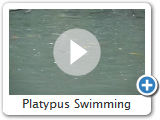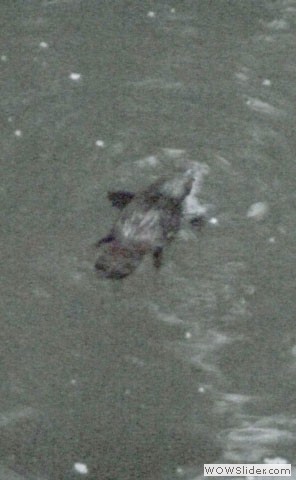Platypus
Ornithorhynchus anatinus
Eungella is a great location to see wild populations of platypus. In particular, there are several locations along Broken River to view platypuses. Platypuses are most active during conditions when there is minimal direct sunlight, such as dawn, dusk, or night-time (Ryan and Burwell 2000, 330). Direct sunlight exposes the platypus to predators for example: birds of prey, foxes, rats, goannas, and snakes. Human interference of land clearing and polluting waterways is a large threat.
Description:
A platypus is 30 to 45 centimetres in length, weighs 1 to 2.4 kilograms, and lives for 12 years. They have a wooly furred coat with three layers. The first layer traps air to keep it warm, the second layer provides insulation, and the third layer detects nearby objects using long flat hairs (Ryan and Burwell 2000, 331). Their webbed feet make them excellent swimmers. They can swim underwater with their eyes shut for up to ten minutes before returning to the surface for oxygen. Naturally buoyant, they must be underneath an object to do this.
Habitat:
Live in freshwater rivers or lakes. They create burrows alongside the riverbank for shelter and protection.
Diet:
Platypuses turn up the bottom mud with their bill and use electroreceptors on the bill to help catch freshwater insects, larvae, and worms. The catch is stored behind the bill in a pouch and they chew and swallow the catch upon returning to the surface. In a day, they can consume their own body weight in food (Ryan and Burwell 2000, 331).
Gender:
Males are larger than females. They mate annually between June to October. Two to four eggs are laid by the female and are incubated for a period of two weeks. Young platypuses feed on milk on the mother's fur that is secreted from glands under the skin (Ryan and Burwell 2000, 332). There is no proper name for platypus offspring, but 'platypup' is popular. Male platypuses defend themselves against predators and other male platypuses using a 15 millimetre spur located behind each hind leg that connects to a venom gland that peaks during mating season.



 1
1 2
2 3
3


 1
1 2
2